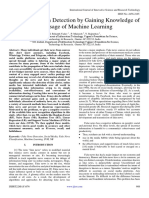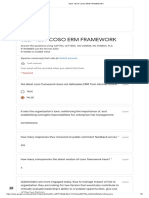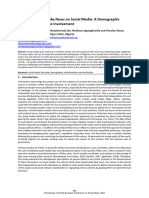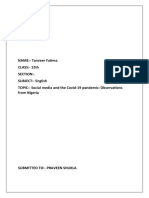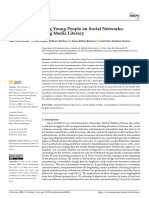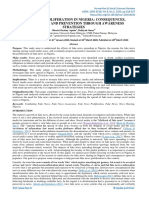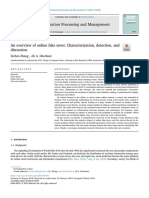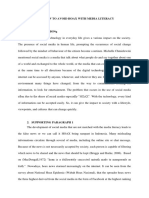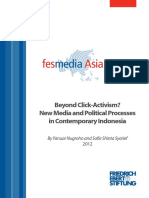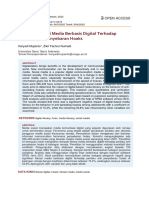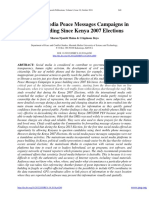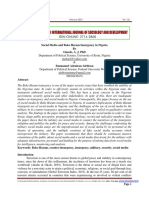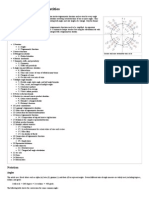Professional Documents
Culture Documents
Social Media Use in Propagating Fake News and Its Influence On Security Challenges in Nigeria Study of Unknown Gunmen
Original Title
Copyright
Available Formats
Share this document
Did you find this document useful?
Is this content inappropriate?
Report this DocumentCopyright:
Available Formats
Social Media Use in Propagating Fake News and Its Influence On Security Challenges in Nigeria Study of Unknown Gunmen
Copyright:
Available Formats
Volume 6, Issue 11, November – 2021 International Journal of Innovative Science and Research Technology
ISSN No:-2456-2165
Social Media Use in Propagating Fake News and Its
Influence on Security Challenges in Nigeria:
Study of Unknown Gunmen
Ugochukwu, Chiemezie Chukwuka Nwolu, Joel Obiajulu Nnabuife, Chika Onyinye
Department of Mass Communication Department of Mass Communication Department of Mass Communication
Nnamdi Azikiwe University, Awka. Nnamdi Azikiwe University, Awka. Nnamdi Azikiwe University, Awka.
Abstract:- Social media have proven to possess the globe share, access and uploads videos. This has made
humongous benefits in information dissemination and social media an invaluable asset cherished and massively
creation of awareness. Given the recent spike in the used by people. According to (Nwabueze, 2014), social
number of attacks perpetrated by armed groups viz-a-viz media have proved to be virile channels of mass
Boko Haram insurgence, banditry, kidnapping and most enlightenment and mobilisation in contemporary society.
recently, the unknown gunmen in the South-East region
of Nigeria, social media serves as veritable tool to create The use of social media platforms in Nigeria has been
security awareness and consciousness. However, the attributed to adaptation and smart mobile phone use in
growth of social media in Nigeria has birthed the Nigeria. Statistics abound on the figures of mobile phone use,
emergence of fake news as a bane to its effective social media and internet use which points to the fact that the
deployment for promoting security awareness. This study market is growing rapidly despite the economic and poor
utilized Survey research method to obtain primary data infrastructure that hampers business development in Nigeria.
from respondents while available literature served as In January, 2021, the number of social media users stood at
secondary data. Technological Determinism theory and 33 million with increase of six million from 2020 to 2021
Disruptive Technology theory were used. The study found (Kemp, 2021). Most Nigerians have seen that the use of social
among other things that social media users spread fake media is an indispensible tool that will aid information
information on social media to gain more followers; also sharing and dissemination. Agreeing to this, (Uzuegbunam,
people do not un-follow social media platforms for 2020) opines that Nigeria is the largest mobile market in
reporting fake stories or news. Fake news spread on social Africa’s growing mobile economy.
media creates panic and tension when rapidly shared by
multiplicity of the audience. The researchers recommend The new media have changed how news is generated,
among others that Government and security agencies shared and read across numerous social media platforms. This
should utilise social media to create security awareness has enabled people who use internet enabled gadgets or smart
among members of the public on how best to react to phones to post several stories on social media whether the
security challenges. facts are right or not. Citizen journalists are reporters or
people who collect news stories, pictures, videos or live
I. INTRODUCTION streaming of an event through social media platforms with
internet enabled smart phones or gadgets. Most citizen
Social media platforms have remained an indispensible journalists are active users of social media platforms like
tool for information dissemination, communication and idea Facebook, Twitter, Instagram, Whatsapp and host of other
sharing. Over the past decade, the innovations and platforms where their followers help to share those stories
improvements across the platforms improved their use and thus, making them go viral. Due to the fact that they are not
accessibility. Social media are internet enabled platforms that trained journalists who adhere to the principle of objective
enables users to share and disseminate information. Put reporting, fake news thrives among many citizen journalists.
succinctly, social media are those internet-based platforms A citizen journalist wants to be the first to break the news on
that create participation, conversation, sharing, collaboration a social media platform without considering the basic
and linkage (Agbo, 2015; Okafor & Onyenekwe, 2020). questions a trained journalist asks before publishing or airing
These platforms have become one of the most commonly a story. Most fake news thrives on social media platforms due
used communication and information methods for people of to internet which aids its spread. Fake news refers to “a type
all ages, gender and Nationalities. Social media platforms are of online disinformation, with totally or partially false
arguably among the fastest means of disseminating content, created intentionally to deceive and/or manipulate a
information and powerful tools for public enlightenment, specific audience, through a format that imitates a news or
mobilization, interaction and exchange (Okafor & report (acquiring credibility), through false information that
Onyenekwe, 2020). Before now, the ability of the media to may or may not be associated with real events, with an
reach a vast audience locally and globally seemed difficult opportunistic structure (title, image, content) to attract the
but social media have closed the gap in reaching and readers’ attention and to persuade them to believe in
impacting huge number of people. News sharing by both falsehood, in order to obtain more clicks and shares across
trained and untrained journalists across social media social media platforms (Joan&Baptista,2020). The above
platforms has radically improved as people from any part of
IJISRT21NOV485 www.ijisrt.com 670
Volume 6, Issue 11, November – 2021 International Journal of Innovative Science and Research Technology
ISSN No:-2456-2165
clearly explains that fake news motive is deliberate intention To find out the impacts of fake news reports on audience
to deceive and create false image and impressions. followership/subscription of a social media platform
The insecurity in Nigeria currently has affected the II. THEORETICAL FRAMEWORK
socio-economic development of the country as every region
is battling with one security challenge to another. The South- A. Technological Determinism Theory
East part of Nigeria is facing a serious challenge largely The foundation of the theory states that technology
caused by heinous activities of unknown gunmen who shapes and determines events in the society. Propounded by
destroy public facilities, kill security operatives and create Marshal McLuhan, who posited that changes in the modes of
atmosphere of fear in the region. communication shape human existence and inventions in
technology invariably cause cultural change (Griffin;
Social media posts on activities of unknown gunmen Nwabueze, 2014). Internet is driven by social media and the
ignite certain feelings for the group, although some Nigerians position of the theory is that such innovation helps change the
who are active users of social media spread certain society and social media platforms have been integrated into
information that is not true about ESN/IPOB and Federal the society. Also, the internet and social media are changing
Government. Since the onset of repeated clashes between the the structure of the society because the social media have
Nigerian army and ESN on January 22, 2021 in Orlu which radically changed the human communication system.
left one person dead, pro-Biafra social media accounts are
alleged to spread false claim about the violence online The spread of fake news across social media platforms
(Olakoyenikan, 2021). on security challenge is achieved through internet. According
to this theory, technology shapes and directs the activities of
Today, millions of Social Media users across Nigeria the society and here the technology is internet. This theory is
and those in the Diaspora are connected to events happening relevant to the study because social media and the internet
in Nigeria, while some use this medium to promote fake have a great impact on the society and it also affects how
news, propaganda and events (Chukwuere & Onyebukwa, people react to news from the media.
2018). In light of this, this study seeks to ascertain social
media use in propagating fake news and its influence on B. Disruptive Technology Theory
security challenges in Nigeria. The concept of Disruptive Technology denotes the
tendency of a new innovation to challenge and alter the values
A. Statement of the Problem and modus operandi that have defined a given activity.
The advent of social media platforms in Nigeria is a Disruptive technology theory was advanced by Clayton
welcome development as people can communicate, share Christensen (1997) to explain how technologies shifted
ideas and information. The new media has been accepted and thinking of marketers on how best to reach audiences for their
adopted by multifaceted groups across all age range in goods and services, sometimes resulting in flawed strategies
Nigeria as a formidable means of communication and social that moved marketers out of comfort zones and away from
interaction. However, social media platforms breed false and established customer base (Berenger & Taha,2012). In other
fake news which threatens the security of the country. The words, it is a technology that tends to redefine the existing
citizens themselves are using the medium to render terror on philosophy and strategy underpinning a given endeavour or
each other by means of fake news and fake postings on social business. In other words, it is a piece of technology that tends
media which promote propaganda and fear (Chukwuere & to redefine the existing philosophy and strategy underpinning
Onyebukwa, 2018). Social media platforms are not regulated, a given endeavour or business. In other words, it is a piece of
therefore, people that are not well exposed to differentiate technology that tends to redefine the existing philosophy and
between fake news and real news fall prey to fake news on strategy underpinning a given endeavour or business.
social media platforms. Due to the fact that news or stories on
social media are not verified or confirmed, it leads to spread Social media platforms have altered the exposure to
of fake news by users. The unrestrictive and affordable nature news and information making it possible for people to have
of the medium has increased its appeal among the populace. easy access to the media. Unlike the traditional media, where
certain restrictions are placed on information gathering and
Manipulating and misinforming the public through dissemination the social media have altered exposure patterns
social media platforms have caused great damage to the and media use. This affirms the position of the Disruptive
security of lives and properties in unprecedented scale in theory that states that technology has changed the old ways
Nigeria. Hence, this study sought to ascertain the role of fake of media use and accessibility.
news in the escalating security challenges deviling the
country, with a particular focus on unknown gunmen in the C. Conceptual Review
South-East region.
Social Media and Fake News
B. Objectives of the study In the past, the media landscape was dominated by the
To ascertain the factors that lead people to spread fake traditional media that performed the role of informing,
news via social media entertaining and educating the people. Presently, the
To determine the effects of fake news spread through Information and Communication Technology have changed
social media on security challenges the entire media and communication industry where people
IJISRT21NOV485 www.ijisrt.com 671
Volume 6, Issue 11, November – 2021 International Journal of Innovative Science and Research Technology
ISSN No:-2456-2165
can connect and share ideas irrespective of where they are. The increase in the use of social media platforms like
The advent of social media is a welcome development in the Facebook, Twitter, WhatsApp and others have increased the
media industry because it has brought a lot of improvement avenue for spread of fake news because the number of people
in communication and interaction. on these platforms are many. The cycle of fake news includes
inventors, consumers, spreaders and channels. Inventors of
The internet drives social media social media platforms fake news concoct stories to misinform, sway opinions,
and without the internet, the social media cannot function. spread propaganda, incite hate, alter perceptions, etc.,
Social media are internet enabled platforms that enables through opinions, predictions and blatant fabricated
people to interact, communicate and share ideas. Internet narratives (Muigai, 2019).
penetration in Nigeria is high and telecommunication
industries are improving on the quality of internet service Insecurity in Nigeria
they offer Nigerians. According to Uzuegbunam, 2020, he In Nigeria the level of insecurity is high and government
opines that Mark Zuckerberg’s visit to Nigeria between is not doing enough to mitigate the negative effect that comes
August and September 2016 was for some internet related with it. Insecurity is virtually destroying the socio-economic
developmental project. Social media refers to the web-based activities of the entire country as each region is battling with
technologies that transforms and broadcast media one security challenge to another. Generally, insecurity refers
monologues into social media dialogues (Kaplan & Haenlin, to state of being in danger or feeling unsecured. Nigeria is
2010; Nwabueze, 2014). From the definition, social media blessed with rich material and human resources and it prides
allows for participation, social association with many people herself as the biggest country in the continent of Africa. No
who utilize the social media. doubt, Nigeria is faced with huge security challenges and
various scholars have pointed out their position on the cause
Across social media platforms, the spread of fake news of insecurity in Nigeria.
has been on the increase. In this era of new media,
distinguishing between real news and fake news has posed a According to (Nweze,2004; Zubairu,2020) ,the writer
difficult problem due to volume of stories that are on social pointed out eight causes of insecurity in Nigeria and it
media platforms. Fake news refers to “a type of online includes: menace of unemployment and poverty, elite
disinformation, with totally or partially false content, created exploitation of ethnicity and religious differences, corruption,
intentionally to deceive and/or manipulate a specific weak security apparatus, porous border, marginalization and
audience, through a format that imitates a news or report inequalities in the country and bad governance and poor
(acquiring credibility), through false information that may or leadership. These problems no doubt currently affect the
may not be associated with real events, with an opportunistic country and its influence on security situation is alarming.
structure (title, image, content) to attract the readers’ attention Security issues affect the Foreign Direct Investment (FDI)
and to persuade them to believe in falsehood, in order to business activities and threat to life and property. In another
obtain more clicks and shares across social media study, (Adegbami, 2013) listed the cause of insecurity to
platforms(Joan&Baptista,2020). From the definition above, include; political factors, leadership factor, unemployment
fake news is also misleading headlines, misleading content or factor, jobs racketeering factor. These factors listed are
any false information that intentionally misleads the public. rearing its ugly head to the security of lives and properties.
Fake news can be categorized into several forms that include:
misleading false news, fabricated false news, intentional false The impacts of the insecurity we have in Nigeria are
news and negligent false news (Thorsten, Lena, Svenja & disturbing. It cut across every facet of the society that
Tim 2019). Misleading false news refers to news that that is currently moving from a state to another in Nigeria is a
not to misled people by presenting false facts to swell security challenge. Ozoigbo, (2019) averred the impacts of
emotions. Fabricated false news is presenting nonexistent insecurity to include; Underdevelopment, Poverty/hunger,
facts to create panic and confusion for the people. Intentional Insurgency/ youth restiveness. Drug abuse / kidnappings,
false news is deliberate issuing out of false news to people to Brain drain and Poor image at the international community.
misinform them. Negligent false news refers to maliciously The impacts of listed factors to the society are numerous that
omitting facts in news or stories. Also (Muigai, 2019) listed no meaningful development can happen where such anomaly
several types Satire or parody - no intention to cause harm but exists. Also, Onime, (2018) is of the view that insecurity
has potential to fool, False connection - when headlines, result to the following factors; Effect on population, Effect on
visuals or captions don't support the content, Misleading oil production, Export and oil revenue, Effect on
content - misleading use of information to frame an issue or unemployment, Effect on Agriculture, Effect on the informal
an individual, False context - when genuine content is shared sector and effect on foreign investment.
with false contextual information, Impostor content - when
genuine sources are “impersonated" with false, made-up In Southeast of Nigeria, the activities of unknown
sources, Manipulated content - when genuine information or gunmen are a deadly monster that the region is grappling
imagery is manipulated to deceive", as with a "doctored" with. The unknown gunmen are responsible for killing
photo, Fabricated content - news content is 100% false, security personnel, destruction of police stations and
designed to deceive and do harm. government properties. South-East has come under
bombardment with attacks coming from three major prongs:
commercial crimes such as kidnapping, ritual killing and
yahoo-yahoo; herdsmen attacks which leave entire
IJISRT21NOV485 www.ijisrt.com 672
Volume 6, Issue 11, November – 2021 International Journal of Innovative Science and Research Technology
ISSN No:-2456-2165
communities desolate; and now, agitators who seem to Table 2: Frequency of respondents’ social media use
acquire “odieshi”-potency- with which they confront military Response Frequency Percentage
and police formations (Chukwu,2021). Unknown gunmen Often 490 49%
have been a source of concern for the people of the region as Always 408 40.8%
people are afraid of moving around. Sometimes 102 10.2 %
Never 0 0%
III. METHODOLOGY Total 1,000 100
Given the nature of this study which sought to determine
the use of social media in propagating fake news and its
influence on security challenges in Nigeria, with a particular
focus on unknown gunmen activities in the South-East
region, the researchers utilized a quantitative research method
involving social media users on WhatsApp and Facebook
platforms. An online questionnaire comprising of closed-
ended and open-ended questions was generated using Google
Forms to ascertain the views and opinions of users with
regard to the research topic and objectives. The generated
questionnaire was sent to respondents through WhatsApp,
Facebook, Twitter and email accounts. The questionnaire was
open for responses between 12th May to 8th June, 2021. A
total of 1,000 responses were received and analysed by the
researchers. Respondents were required to answer 13 Table 2 shows that 89% of the respondents make use
questions. The Microsoft Excel was used in analysing the of social media either often or always while a meager 10.2%
collected data while tables and charts are used to present data. occasionally use social media. This implies that social
media are in high demand by the respondents as affirmed by
IV. DATA PRESENTATION AND ANALYSIS majority of the respondents.
This section presents the results of the Survey study Table 3: Awareness of unknown gunmen attacks
conducted. From the data collected, answers to the research Response Frequency Percentage
questions which guided the study are presented below: Yes 490 93.9%
No 408 6.1%
Table 1: Respondents’ choice of social media Total 1,000 100
Response Frequency Percentage
WhatsApp 667 66.7
Facebook 167 16.7
Instagram 125 12.5
Twitter 41 4.1
Total 1,000 100
An analysis of table 3 indicates that bulks of the
respondents (93.9%) are aware of the activities of the
unknown gunmen in the southeastern region of Nigeria. A
paltry 6.1% said they are not aware of their attacks. This
shows that awareness of the security threat posed by the
armed group is prevalent among the respondents.
Data from table 1 indicate that majority of the
respondents make use of WhatsApp (66.7%) while a distant
16.7% utilise Facebook. Twitter is the least used social media
platform with only 4.1% of the respondents affirming to
usage of the micro blogging platform.
IJISRT21NOV485 www.ijisrt.com 673
Volume 6, Issue 11, November – 2021 International Journal of Innovative Science and Research Technology
ISSN No:-2456-2165
Table 4: Factors that lead users to spread fake news fake news stories have sometimes increased the frequency of
Response Frequency Percentage the attacks.
To gain more 550 55%
followers The respondents thereafter highlighted examples of how
290 29% fake news has helped hike insecurity in the open-ended
Haste to break section of the questionnaire. Instances identified by
the news 160 16% respondents includes: The guy that was shot in Ifite by
armed group was an Anti-cult member. But on some of
To heighten social media sites, I read he was a cultist; Reports of
panic among the 1,000 100 robberies that don't actually happen in Awka presently, we
people don't know the difference between gunmen attacks and cult
clash because both are ongoing in the city; Other groups
Total like cults, robbers, even the police now attack and even
steal from people and the unknown gunmen are blamed
even when it's not them; If there is a false information
stating that the federal government will be deploying army
troops to a certain area in the south east area, this will ignite
the unknown gunmen because they are always pissed when
they hear such news. I say this because of the frequent gun
battle between the military and the unknown gunmen. I
believe some of these unknown gunmen are locals of those
areas, so, it may give hurtful propaganda and views to
probably an opposing party of persons who as a result of
such news, may decide to retaliate therefore bringing a rise
to the increase of the unknown gunmen.
Table 6: Responses on whether the attacks have affected
them
Response Frequency Percentage
Findings in the table shows that majority of the Yes 82 8.2%
respondents (55%) said they were influenced to share fake No 469 46.9%
news in an attempt to gain more followers by spreading recent Not directly 449 44.9%
news occurrence while 29% were in a haste to break to news, Total 1,000 100
neglecting fact check. Also, 16% of the respondents said it
was an attempt to create panic.
Table 5: Responses on if fake news has increased the spate
of unknown gunmen attacks in South-East
Response Frequency Percentage
Yes 500 50%
No 229 22.9%
Sometimes 271 27.1%
Total 1,000 100
Data from table 6 shows that most of the respondents
representing 46.9% are not affected by the unknown
gunmen attacks, closely followed by 44.9 percent who are
not directly directly. Only 8.2% said they were affected.
This shows that the activities of the group do not affected
majority of residents in the South-East zone.
Accounts of respondents’ experience
The respondents’ highlighted how the activities of the
unknown gunmen have affected them in the open-ended
An analysis of table 5 shows that half of the respondents section of the questionnaire. Experiences narrated include:
agree that fake news have increased the spate of unknown It concerns South East which is my region; I stay in Awka.
gunmen attacks in the South-East while a meager 22.9 The proximity of the attacks gives me serious worries and
percent disagree to that effect. A paltry 27.1 also agree that trauma coupled with the current cult situation in UNIZIK
IJISRT21NOV485 www.ijisrt.com 674
Volume 6, Issue 11, November – 2021 International Journal of Innovative Science and Research Technology
ISSN No:-2456-2165
where I study; I was arrested as a journalist while covering of unknown gunmen shared on social media are believed by
one of the attacks; My uncle was attacked can't give account the majority of the respondents.
of it; the armed men gunned down a fellow just in front of my
lodge. Table 9: Responses on verification of the source(s) of the
stories
Table 7: Do you follow social media posts on the attacks Response Frequency Percentage
Response Frequency Percentage Yes 250 25%
Yes 388 38.8% No 295 29.5%
No 265 26.5% Sometimes 432 43.2%
Sometimes 347 34.7% Never 23 2.3%
Total 1,000 100 Total 1,000 100
The table indicates that most of the respondents (38.8%) An analysis of table 8 shows that majority of the
follow updates on the attacks while 26.5% do not follow respondents 43.2% verify story sources sometimes while
social media posts on the attacks and a further 34.7% of the 25.5% affirm to doing so. This is followed by 29.5% of the
respondents do not sometimes. This shows that majority of respondents who do not bother to very news source and a
the respondents are interested and informed of the attacks in paltry 2.3% who have never verified story sources. The data
the South-East region. points to the fact that most social media users 68.2 % verify
the source of stories they access. This is opposed to 31.3
Table 8: Responses on believability of stories on unknown percent who do not bother to do so.
gunmen
Response Frequency Percentage Table 10: Responses on whether the respondents have
Yes 388 38.8% ever shared unverified stories about the unknown gunmen
No 20 2% attacks
Sometimes 592 59.2% Response Frequency Percentage
Total 1,000 100 Yes 82 8.2%
No 898 89.8%
Sometimes 20 2%
Total 100 100
Table 8 shows that almost all the respondents
representing 98% either believe social media news on
unknown gunmen or do so occasionally. A distant 2% said
they do not believe stories on insecurity in the South-East. Table 10 shows that only 8.2 percent of the respondents
The data shows there are social media stories on the activities agreed to have shared unverified stories on unknown gunmen
while a majority 89.8 percent has never shared fake news on
IJISRT21NOV485 www.ijisrt.com 675
Volume 6, Issue 11, November – 2021 International Journal of Innovative Science and Research Technology
ISSN No:-2456-2165
the activities of the group. This shows that social media users affirms the massive use of social media in Nigeria. In
are not in a haste to share unverified news stories on the January, 2021, the number of social media users stood at 33
group. million with increase of six million from 2020 to 2021
(Kemp, 2021)
Table 11: Have you had to unfollow social media handle
for spreading fake news? Furthermore, the study set out to examine the use of
Response Frequency Percentage social media in propagating fake news and its influence on
Yes 490 49% security challenges in Nigeria: a study of unknown gunmen.
No 510 51% The study is important as social media have become a core
Total 1,000 100 companion of several Nigerian youths today. Insecurity on
the other hand has become a major challenge for the
government of the day and security agencies to combat.
Findings show that most of the respondents - 66.7 percent use
WhatsApp to access news stories, followed by Facebook and
Instagram. Twitter is the least used social media platform
among the respondents.
The research also revealed that bulk of the respondents
89% use social media regularly while a paltry 10.2 percent
affirm using social media sometimes. It serves as a pointer
that social media is widely used by the respondents to access
information. Also, findings show that there is high rate of
awareness of the activities of unknown gunmen in the region
among the respondents is high judging from 93.9 percent who
are aware of their activities.
The data captured in table 11 above shows that more
than half of the respondents (51%) have not had to unfollow Despite the established security threat posed by the
a news platform for reporting a fake news story. On the unknown gunmen, a higher percentage of the respondents
other hand, 49% have unfollowed a platform for reporting (91.8%) posit that they are not directly affected by the
fake news. This shows that fake news does not impact on activities of the group. While only 8.2 percent of the
the subscription and or followership of a particular news respondents agree to being affected. Narrating how the
platform by readers. attacks have affected them, the respondents said among other
things that it has put them in constant panic, another who is a
V. DISCUSSION OF FINDINGS, CONCLUSION journalist was arrested while covering one of the attacks in
AND RECOMMENDATION Awka while one said his uncle was attacked.
On the research question which sought to ascertain the Other findings show that though fake news is prevalent
factors that lead people to spread fake news via social media, on varied social media platforms, the majority of the
the study found that 55% of the respondents said they spread respondents (98%) believe stories on the attacks. The study
fake news on social media platforms to gain more followers proves that a high percentage of those (68.2) make conscious
of people on social media platforms. This is an ugly effort to verify the source of stories they access on the attacks
development that will worsen the security challenge in the of the group. Also, the study revealed that majority of the
country. Social media platforms promote and rewards people respondents (89.8) do not share unverified news stories on
that have many followers and this could lead to spread of fake their social media handles, while more than half of the
news. This affirms what Joan&Baptista,2020 said that fake respondents (57.1%) believe that fake news has been an
news attract the readers’ attention and persuades them to important factor in escalating the spate of attacks. However,
believe in falsehood, in order to obtain more clicks and shares despite their believe in the negative impact of fake news, most
across social media platforms(Joan&Baptista,2020). of the respondents (51%) have not had to un-follow a social
media handle for reporting a fake news.
The second research question that sought to determine
the effects of fake news spread through social media on The researchers therefore conclude the following: most
security challenges, the study found that fake news spread of the studied audience use social media to access news
contributed to security currently experienced in the country. stories. A higher percentage also do so regularly compared to
This agrees with (Thorsten, Lena, Svenja & Tim 2019) that those that do not. This shows the high appeal of social media
false news is misleading, fabricated, intentional and in the society. Majority of the respondents are equally aware
negligent. of the activities of the unknown gunmen in the South-East
region. However, responses showed that there activities not
Lastly, to find out the impacts of fake news reports on directly affect most people in the region. The study also
audience followership/subscription of a social media agrees that there is high level of believability of news stories
platform if found that social media users do not unfollow on social media by users despite the negative influence that
social media platforms for reporting a fake news story. This fake news possesses. Interestingly, fact checking is popular
IJISRT21NOV485 www.ijisrt.com 676
Volume 6, Issue 11, November – 2021 International Journal of Innovative Science and Research Technology
ISSN No:-2456-2165
among the people as pointed out by responses on verification [12]. Ozoigbo, B. (2019). Insecurity in Nigeria: Genesis,
of news authenticity. This prompts them not to share Consequences and Panacea. http://oapub.org On June
unverified news stories. 4th,2021.
[13]. Thoresten, Q. , Lena, E., Svenja, B. & Tim, E. (2019).
Interestingly, the respondents agree that fake news Fake News. http://reserachgate.com
contributes to escalation of unknown gunmen attacks. [14]. Uzuegbunam, C. (2020). Communication and Media
However, fake news does not lead users to unfollow social Studies Multiple Perspectives. Enugu: New Generation
media handles of news platforms. Books.
[15]. Zubairu, N. (2020). Rising Insecurity in Nigeria: Causes
RECOMMENDATION & Solutions. in Journal of Studies in Social Sciences.
http://infinitypress.info
The study recommends the following:
There should be increased social media channeled
sensitization on fake news and how users can
independently verify the source/authenticity of news
stories they access to rid the platform of misleading
information.
Government and security agencies should utilise social
media to create security awareness among members of the
public on how best to react to security challenges.
Also, security agencies should monitor and harness social
media as an avenue to get information on distress
situations as most people would rather upload a security
bridge on social media than call the police.
Security agencies should ensure that they respond quickly
to distress alerts raised on social media platforms.
REFERENCES
[1]. Adegbami, A. (2013). Insecurity: A Threat to Human
Existence and Economic Development In Nigeria.
http://iiste.org/journals. June 5th, 2021.
[2]. Berenger, R & Taha, M. (2012). Technology Disruption
theory and Middle East Media. http://academia.edu. On
July 15,2021.
[3]. Chukwu, I. (2021). High cost of Rising insecurity in
South-East Nigeria. http://businessday.ng June 6th,
2021.
[4]. Chukwuere, J & Onyebukwa, C. (2018). The Impacts of
Social Media on National Security: A View from the
Northern & South-Eastern Region of Nigeria.
http://ecojournals.com June, 6th, 2021.
[5]. Kemp, S. (2021). Digital 2021: Nigeria.
http://datareportal.com. On July5th,2021.
[6]. Joan, A. & Baptista. (2020). Understanding Fake News
Consumption: A Review. http://semanticscholar.org
[7]. Muigai, J. (2019). Understanding fake news.
International Journal of Scientific Research.
http://researchgate.com. On June 6th,2021.
[8]. Nwabueze, C. (2014). Introduction to Mass
Communication. Media Ecology in the Global Village
. Owerri: Topshelve Publishers.
[9]. Okafor, E. & Onyenekwe, O. (2020). Communication
and Media Studies Multiple Perspectives. Enugu: New
Generation Books.
[10]. Onime, B. (2018). Insecurity & Economic Growth in
Nigeria: A Diagnostic Review. http://eujournal.org.
June 6th, 2021.
[11]. Olakoyenikan, S. (2021). False Claims circulate online
following unrest in Nigeria’s South-East.
http://factcheck.afp.com.
IJISRT21NOV485 www.ijisrt.com 677
You might also like
- Sunday School Lesson Activity 219 Moses Builds A Tablernacle in The Wilderness - Printable 3D Model KitDocument17 pagesSunday School Lesson Activity 219 Moses Builds A Tablernacle in The Wilderness - Printable 3D Model Kitmcontrerasseitz3193No ratings yet
- Fake News DetectionDocument5 pagesFake News DetectionInternational Journal of Innovative Science and Research TechnologyNo ratings yet
- List of Blade MaterialsDocument19 pagesList of Blade MaterialsAnie Ummu Alif & SyifaNo ratings yet
- Rate of ChangeDocument22 pagesRate of ChangeTrisha MariehNo ratings yet
- Max-OT For Dummies - Bodybuilding - Com ForumsDocument21 pagesMax-OT For Dummies - Bodybuilding - Com ForumsPhong QuachNo ratings yet
- Fake Information Detection by Gaining Knowledge of The Usage of Machine LearningDocument5 pagesFake Information Detection by Gaining Knowledge of The Usage of Machine LearningInternational Journal of Innovative Science and Research TechnologyNo ratings yet
- Passenger Handling Presentation 2020Document305 pagesPassenger Handling Presentation 2020Elshaikh100% (1)
- Self-test on the COSO ERM frameworkDocument6 pagesSelf-test on the COSO ERM frameworkLady BirdNo ratings yet
- Gray Iron Castings: Standard Specification ForDocument6 pagesGray Iron Castings: Standard Specification Forsafak kahramanNo ratings yet
- Mercedes Vario 1996 2003 PDF Service ManualDocument22 pagesMercedes Vario 1996 2003 PDF Service Manualveronicamurphy070288aqwNo ratings yet
- Danh sách KH Biệt Thự Thảo Điền - Quận 2Document4 pagesDanh sách KH Biệt Thự Thảo Điền - Quận 2La TraNo ratings yet
- Project Management OfficeDocument42 pagesProject Management OfficeqazqazNo ratings yet
- Impacts of Information Age on SocietyDocument13 pagesImpacts of Information Age on SocietyNathan VieselNo ratings yet
- Video Conferencing Lesson PlanDocument6 pagesVideo Conferencing Lesson PlanANN JILLIAN JOYCE MONDONEDO100% (1)
- ZZZZZ +kayode Adedeji+ESM 015 OJS+166Document9 pagesZZZZZ +kayode Adedeji+ESM 015 OJS+166Zenal AbNo ratings yet
- A Study of Fake News in Social Media in NigeriaDocument54 pagesA Study of Fake News in Social Media in NigeriaBatiyaNo ratings yet
- Social media's role in spreading info and misinfo during Nigeria's Covid-19 pandemicDocument13 pagesSocial media's role in spreading info and misinfo during Nigeria's Covid-19 pandemicsaim asadNo ratings yet
- Combatting Fake News in Nigeria A Multifaceted Approach For Information Integrity and Societal ResilienceDocument3 pagesCombatting Fake News in Nigeria A Multifaceted Approach For Information Integrity and Societal ResilienceKIU PUBLICATION AND EXTENSIONNo ratings yet
- The Descriptive Analysis of Hoax Spread Through Social Media in Indonesia Media PerspectiveDocument11 pagesThe Descriptive Analysis of Hoax Spread Through Social Media in Indonesia Media PerspectiveSandryones PalinggiNo ratings yet
- Digital Information and Media LiteracyDocument15 pagesDigital Information and Media LiteracyudontneedtoknowNo ratings yet
- HUMSS-C Practical Research 1 (Group 5)Document19 pagesHUMSS-C Practical Research 1 (Group 5)yolayolayola1111No ratings yet
- MSC PROJECT 1 To 3 FINAL CORRECTIONDocument70 pagesMSC PROJECT 1 To 3 FINAL CORRECTIONMajesty100% (1)
- Fake NewsDocument13 pagesFake NewsudontneedtoknowNo ratings yet
- Social Media and Sit at Home (Nnam Jude)Document51 pagesSocial Media and Sit at Home (Nnam Jude)Pst W C PetersNo ratings yet
- Rohith.K-Defensive Modeling of Fake News Through Online Social NetworksDocument9 pagesRohith.K-Defensive Modeling of Fake News Through Online Social NetworksAnil KumarNo ratings yet
- Impact of MIL on Students' Skills to Detect Fake NewsDocument26 pagesImpact of MIL on Students' Skills to Detect Fake NewsT LNo ratings yet
- Social media's role in raising awareness of police brutality in NigeriaDocument15 pagesSocial media's role in raising awareness of police brutality in NigeriaOffiaNo ratings yet
- The Impact of Social Media On Privacy Due To The Lack of Digital Literacy From Generation Z During Covid-19Document7 pagesThe Impact of Social Media On Privacy Due To The Lack of Digital Literacy From Generation Z During Covid-19Catherine Yati OoNo ratings yet
- Dec 2022 15Document21 pagesDec 2022 15Sourav Shekhar 1065No ratings yet
- Technological Forecasting & Social Change: A B B C BDocument14 pagesTechnological Forecasting & Social Change: A B B C BmasreshaNo ratings yet
- SOCIAL MEDIA Vs ACCOUNTABILITYDocument17 pagesSOCIAL MEDIA Vs ACCOUNTABILITYOLAOLUWA AZEEZATNo ratings yet
- Fake News SurveyDocument12 pagesFake News SurveynamieNo ratings yet
- Deepfakes NotesDocument22 pagesDeepfakes NotesNor Jijidiana AzmiNo ratings yet
- The Spreading of Misinformationthrough Social Network SitesDocument2 pagesThe Spreading of Misinformationthrough Social Network SitesInternational Journal of Innovative Science and Research TechnologyNo ratings yet
- Effect of Social Media Usage On The Lifestyles of Youth: Vol. 19. No. 4 (2022) - 60-69. ISSN: 1823-884xDocument11 pagesEffect of Social Media Usage On The Lifestyles of Youth: Vol. 19. No. 4 (2022) - 60-69. ISSN: 1823-884xEstrada, Dominic F.No ratings yet
- 4 Internet Meme As A CampaignDocument14 pages4 Internet Meme As A Campaignchristian adicandraNo ratings yet
- Fake News Detection Using Machine Learning Algorithms IJERTCONV9IS03104Document10 pagesFake News Detection Using Machine Learning Algorithms IJERTCONV9IS03104favour chimaNo ratings yet
- 3023-Article Text-11715-1-10-20211231Document14 pages3023-Article Text-11715-1-10-20211231Ferdhi AndrisyahNo ratings yet
- Publications: Fake News Reaching Young People On Social Networks: Distrust Challenging Media LiteracyDocument16 pagesPublications: Fake News Reaching Young People On Social Networks: Distrust Challenging Media LiteracyYoussef Ait OuammiNo ratings yet
- Twitter Civil Activisms and EndSARS Protest in Nigeria As A Developing DemocracyDocument23 pagesTwitter Civil Activisms and EndSARS Protest in Nigeria As A Developing DemocracyMajestyNo ratings yet
- Jan.18 EditDocument53 pagesJan.18 EditRodgyNo ratings yet
- Young Nigerians Social Media Engagement for Social ChangeDocument24 pagesYoung Nigerians Social Media Engagement for Social ChangekassimNo ratings yet
- 2468-Main Article Text-7554-1-10-20200328Document10 pages2468-Main Article Text-7554-1-10-20200328JustinoLucasNo ratings yet
- 2IJMME1Document14 pages2IJMME1Bamidele ElimianNo ratings yet
- Literasi MediaDocument14 pagesLiterasi MediaArif MuhammadNo ratings yet
- 1 s2.0 S0306457318306794 Main PDFDocument26 pages1 s2.0 S0306457318306794 Main PDFCharlène HebertNo ratings yet
- Mass Media and InSecurityDocument4 pagesMass Media and InSecurityOloye ElayelaNo ratings yet
- How To Avoid Hoax With Media LiteracyDocument3 pagesHow To Avoid Hoax With Media LiteracyNorma SyahidahNo ratings yet
- Media Research Lab File (Tanmay Kar & Rishabh Sajwan) 2Document34 pagesMedia Research Lab File (Tanmay Kar & Rishabh Sajwan) 2Nancy BishtNo ratings yet
- Vicente - Woal & BlogDocument6 pagesVicente - Woal & BlogVieyah Angela VicenteNo ratings yet
- Virtual Information and ProblemDocument6 pagesVirtual Information and ProblemMitch Jasdale Mentar QuimotNo ratings yet
- Series: Beyond Click-Activism? New Media and Political Processes in Contemporary IndonesiaDocument113 pagesSeries: Beyond Click-Activism? New Media and Political Processes in Contemporary IndonesiaiqbalmuhtaromNo ratings yet
- The Study of Dangers and Countermeasures of Fake News in Social MediaDocument6 pagesThe Study of Dangers and Countermeasures of Fake News in Social MediaInternational Journal of Multidisciplinary Research and Explorer (IJMRE)No ratings yet
- Online Engagements and Nigerian Polity Exploring Users Reactions To Election Results On FacebookDocument12 pagesOnline Engagements and Nigerian Polity Exploring Users Reactions To Election Results On FacebookInternational Journal of Advance Study and Research WorkNo ratings yet
- PBHE0490 Nandal Chapter15 ProofDocument24 pagesPBHE0490 Nandal Chapter15 ProofJerrryyNo ratings yet
- Social Media AdvertisingMarketing A Study of AwareDocument25 pagesSocial Media AdvertisingMarketing A Study of AwareAlex AransiolaNo ratings yet
- Understanding the influence of Twitter on Nigerian Youths during the ENDSARS Protest by Ofure AmenkhienanDocument34 pagesUnderstanding the influence of Twitter on Nigerian Youths during the ENDSARS Protest by Ofure AmenkhienanamenkhienanoNo ratings yet
- Dampak Literasi Media Digital Terhadap Perilaku Anti Penyebaran HoaksDocument17 pagesDampak Literasi Media Digital Terhadap Perilaku Anti Penyebaran HoaksRoberto MochamadNo ratings yet
- Nigeria's Social Media Culture Exploring Civic Participation of Youths in The 2015 Presidential ElectionDocument12 pagesNigeria's Social Media Culture Exploring Civic Participation of Youths in The 2015 Presidential ElectionInternational Journal of Advance Study and Research WorkNo ratings yet
- Ijsrp p8280Document19 pagesIjsrp p8280Abdilahi AdenNo ratings yet
- Social Media and Boko Haram Insurgency in NigeriaDocument12 pagesSocial Media and Boko Haram Insurgency in NigeriaEmmanuelNo ratings yet
- Program ProposalDocument16 pagesProgram ProposalMarigold JaymeNo ratings yet
- Regulating social media to curb hate speechDocument10 pagesRegulating social media to curb hate speechGlascow universityNo ratings yet
- Lesson 7 - Opportunities and Threats in Media and Information LiteracyDocument47 pagesLesson 7 - Opportunities and Threats in Media and Information LiteracyMark Anthony AurellanoNo ratings yet
- ReseschDocument14 pagesReseschJohn Rey BelchesNo ratings yet
- Chapter One EditedDocument21 pagesChapter One EditedBillie HatmanNo ratings yet
- Not Everything You Read Is True Fake News Detection Using Machine Learning AlgorithmsDocument4 pagesNot Everything You Read Is True Fake News Detection Using Machine Learning Algorithmssba23088No ratings yet
- Social Media Does More Harm Than GoodDocument4 pagesSocial Media Does More Harm Than GoodQuyen TranNo ratings yet
- Post-Truth in Social Media: December 2019Document14 pagesPost-Truth in Social Media: December 2019shakeDNo ratings yet
- Cyberculture And Cancel Culture: Repercussions On Image And Advertising CommunicationFrom EverandCyberculture And Cancel Culture: Repercussions On Image And Advertising CommunicationNo ratings yet
- An Analysis on Mental Health Issues among IndividualsDocument6 pagesAn Analysis on Mental Health Issues among IndividualsInternational Journal of Innovative Science and Research TechnologyNo ratings yet
- Harnessing Open Innovation for Translating Global Languages into Indian LanuagesDocument7 pagesHarnessing Open Innovation for Translating Global Languages into Indian LanuagesInternational Journal of Innovative Science and Research TechnologyNo ratings yet
- Diabetic Retinopathy Stage Detection Using CNN and Inception V3Document9 pagesDiabetic Retinopathy Stage Detection Using CNN and Inception V3International Journal of Innovative Science and Research TechnologyNo ratings yet
- Investigating Factors Influencing Employee Absenteeism: A Case Study of Secondary Schools in MuscatDocument16 pagesInvestigating Factors Influencing Employee Absenteeism: A Case Study of Secondary Schools in MuscatInternational Journal of Innovative Science and Research TechnologyNo ratings yet
- Exploring the Molecular Docking Interactions between the Polyherbal Formulation Ibadhychooranam and Human Aldose Reductase Enzyme as a Novel Approach for Investigating its Potential Efficacy in Management of CataractDocument7 pagesExploring the Molecular Docking Interactions between the Polyherbal Formulation Ibadhychooranam and Human Aldose Reductase Enzyme as a Novel Approach for Investigating its Potential Efficacy in Management of CataractInternational Journal of Innovative Science and Research TechnologyNo ratings yet
- The Making of Object Recognition Eyeglasses for the Visually Impaired using Image AIDocument6 pagesThe Making of Object Recognition Eyeglasses for the Visually Impaired using Image AIInternational Journal of Innovative Science and Research TechnologyNo ratings yet
- The Relationship between Teacher Reflective Practice and Students Engagement in the Public Elementary SchoolDocument31 pagesThe Relationship between Teacher Reflective Practice and Students Engagement in the Public Elementary SchoolInternational Journal of Innovative Science and Research TechnologyNo ratings yet
- Dense Wavelength Division Multiplexing (DWDM) in IT Networks: A Leap Beyond Synchronous Digital Hierarchy (SDH)Document2 pagesDense Wavelength Division Multiplexing (DWDM) in IT Networks: A Leap Beyond Synchronous Digital Hierarchy (SDH)International Journal of Innovative Science and Research TechnologyNo ratings yet
- Comparatively Design and Analyze Elevated Rectangular Water Reservoir with and without Bracing for Different Stagging HeightDocument4 pagesComparatively Design and Analyze Elevated Rectangular Water Reservoir with and without Bracing for Different Stagging HeightInternational Journal of Innovative Science and Research TechnologyNo ratings yet
- The Impact of Digital Marketing Dimensions on Customer SatisfactionDocument6 pagesThe Impact of Digital Marketing Dimensions on Customer SatisfactionInternational Journal of Innovative Science and Research TechnologyNo ratings yet
- Electro-Optics Properties of Intact Cocoa Beans based on Near Infrared TechnologyDocument7 pagesElectro-Optics Properties of Intact Cocoa Beans based on Near Infrared TechnologyInternational Journal of Innovative Science and Research TechnologyNo ratings yet
- Formulation and Evaluation of Poly Herbal Body ScrubDocument6 pagesFormulation and Evaluation of Poly Herbal Body ScrubInternational Journal of Innovative Science and Research TechnologyNo ratings yet
- Advancing Healthcare Predictions: Harnessing Machine Learning for Accurate Health Index PrognosisDocument8 pagesAdvancing Healthcare Predictions: Harnessing Machine Learning for Accurate Health Index PrognosisInternational Journal of Innovative Science and Research TechnologyNo ratings yet
- The Utilization of Date Palm (Phoenix dactylifera) Leaf Fiber as a Main Component in Making an Improvised Water FilterDocument11 pagesThe Utilization of Date Palm (Phoenix dactylifera) Leaf Fiber as a Main Component in Making an Improvised Water FilterInternational Journal of Innovative Science and Research TechnologyNo ratings yet
- Cyberbullying: Legal and Ethical Implications, Challenges and Opportunities for Policy DevelopmentDocument7 pagesCyberbullying: Legal and Ethical Implications, Challenges and Opportunities for Policy DevelopmentInternational Journal of Innovative Science and Research TechnologyNo ratings yet
- Auto Encoder Driven Hybrid Pipelines for Image Deblurring using NAFNETDocument6 pagesAuto Encoder Driven Hybrid Pipelines for Image Deblurring using NAFNETInternational Journal of Innovative Science and Research TechnologyNo ratings yet
- Terracing as an Old-Style Scheme of Soil Water Preservation in Djingliya-Mandara Mountains- CameroonDocument14 pagesTerracing as an Old-Style Scheme of Soil Water Preservation in Djingliya-Mandara Mountains- CameroonInternational Journal of Innovative Science and Research TechnologyNo ratings yet
- A Survey of the Plastic Waste used in Paving BlocksDocument4 pagesA Survey of the Plastic Waste used in Paving BlocksInternational Journal of Innovative Science and Research TechnologyNo ratings yet
- Hepatic Portovenous Gas in a Young MaleDocument2 pagesHepatic Portovenous Gas in a Young MaleInternational Journal of Innovative Science and Research TechnologyNo ratings yet
- Design, Development and Evaluation of Methi-Shikakai Herbal ShampooDocument8 pagesDesign, Development and Evaluation of Methi-Shikakai Herbal ShampooInternational Journal of Innovative Science and Research Technology100% (3)
- Explorning the Role of Machine Learning in Enhancing Cloud SecurityDocument5 pagesExplorning the Role of Machine Learning in Enhancing Cloud SecurityInternational Journal of Innovative Science and Research TechnologyNo ratings yet
- A Review: Pink Eye Outbreak in IndiaDocument3 pagesA Review: Pink Eye Outbreak in IndiaInternational Journal of Innovative Science and Research TechnologyNo ratings yet
- Automatic Power Factor ControllerDocument4 pagesAutomatic Power Factor ControllerInternational Journal of Innovative Science and Research TechnologyNo ratings yet
- Review of Biomechanics in Footwear Design and Development: An Exploration of Key Concepts and InnovationsDocument5 pagesReview of Biomechanics in Footwear Design and Development: An Exploration of Key Concepts and InnovationsInternational Journal of Innovative Science and Research TechnologyNo ratings yet
- Mobile Distractions among Adolescents: Impact on Learning in the Aftermath of COVID-19 in IndiaDocument2 pagesMobile Distractions among Adolescents: Impact on Learning in the Aftermath of COVID-19 in IndiaInternational Journal of Innovative Science and Research TechnologyNo ratings yet
- Studying the Situation and Proposing Some Basic Solutions to Improve Psychological Harmony Between Managerial Staff and Students of Medical Universities in Hanoi AreaDocument5 pagesStudying the Situation and Proposing Some Basic Solutions to Improve Psychological Harmony Between Managerial Staff and Students of Medical Universities in Hanoi AreaInternational Journal of Innovative Science and Research TechnologyNo ratings yet
- Navigating Digitalization: AHP Insights for SMEs' Strategic TransformationDocument11 pagesNavigating Digitalization: AHP Insights for SMEs' Strategic TransformationInternational Journal of Innovative Science and Research TechnologyNo ratings yet
- Drug Dosage Control System Using Reinforcement LearningDocument8 pagesDrug Dosage Control System Using Reinforcement LearningInternational Journal of Innovative Science and Research TechnologyNo ratings yet
- The Effect of Time Variables as Predictors of Senior Secondary School Students' Mathematical Performance Department of Mathematics Education Freetown PolytechnicDocument7 pagesThe Effect of Time Variables as Predictors of Senior Secondary School Students' Mathematical Performance Department of Mathematics Education Freetown PolytechnicInternational Journal of Innovative Science and Research TechnologyNo ratings yet
- Formation of New Technology in Automated Highway System in Peripheral HighwayDocument6 pagesFormation of New Technology in Automated Highway System in Peripheral HighwayInternational Journal of Innovative Science and Research TechnologyNo ratings yet
- Research Trends On Environmental Energy and Vulnerability - 2021 - Energy andDocument27 pagesResearch Trends On Environmental Energy and Vulnerability - 2021 - Energy andCynthia Mac-beathNo ratings yet
- Vernacular Terms in Philippine ConstructionDocument3 pagesVernacular Terms in Philippine ConstructionFelix Albit Ogabang IiiNo ratings yet
- SKM 4 - COCU - CU2 - Child - Care - Centre - HealthDocument14 pagesSKM 4 - COCU - CU2 - Child - Care - Centre - HealthShireen TahirNo ratings yet
- A933 Transistor DatasheetDocument5 pagesA933 Transistor Datasheetshorman67134No ratings yet
- PV380 Operations ManualDocument20 pagesPV380 Operations ManualCarlosNo ratings yet
- English Assignment Team:: Devia Annisa E. E44190045 2. TB. Aditia Rizki E44190027 3. Tedi Irfan Jelata E44190028Document3 pagesEnglish Assignment Team:: Devia Annisa E. E44190045 2. TB. Aditia Rizki E44190027 3. Tedi Irfan Jelata E4419002856TB. Aditia RizkiNo ratings yet
- The 9 Building Blocks of Business ModelsDocument3 pagesThe 9 Building Blocks of Business ModelsTobeFrankNo ratings yet
- Quantitative Data Analysis 2Document10 pagesQuantitative Data Analysis 2Rhona MaandalNo ratings yet
- MathWorks Interview ProcessDocument2 pagesMathWorks Interview ProcessPawan Singh100% (1)
- Understanding Income Statements EPS CalculationsDocument39 pagesUnderstanding Income Statements EPS CalculationsKeshav KaplushNo ratings yet
- Tata Steel-MDP SessionDocument69 pagesTata Steel-MDP Sessionsasharma82No ratings yet
- Qualitative Research On Vocabulary and Spelling Skills of A Student Chapters I IIIDocument23 pagesQualitative Research On Vocabulary and Spelling Skills of A Student Chapters I IIIarniza blazoNo ratings yet
- List of Trigonometric IdentitiesDocument16 pagesList of Trigonometric IdentitiesArnab NandiNo ratings yet
- Belotero Intense LidocaineDocument7 pagesBelotero Intense LidocaineAnnaNo ratings yet
- READING U8Document4 pagesREADING U8Như TrầnNo ratings yet
- Aling Presing ChichacornDocument2 pagesAling Presing ChichacornMhel Joshua Bautista HermitanioNo ratings yet
- Number SystemDocument4 pagesNumber SystemGlenn ThomasNo ratings yet
- ALGEBRA Groups 1Document34 pagesALGEBRA Groups 1bravemacnyNo ratings yet
- Akuntansi Keuangan Lanjutan - Akuntansi Penggabungan UsahaDocument67 pagesAkuntansi Keuangan Lanjutan - Akuntansi Penggabungan UsahachendyNo ratings yet





